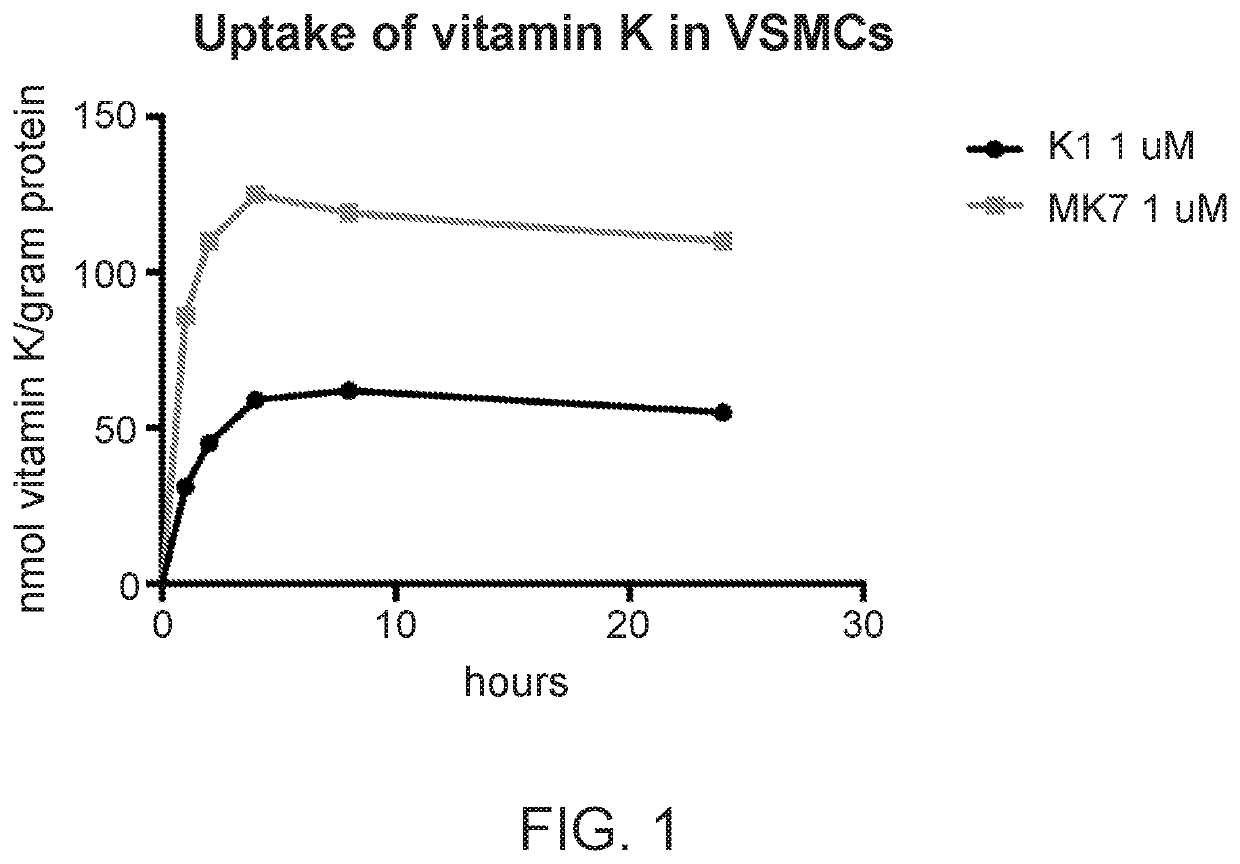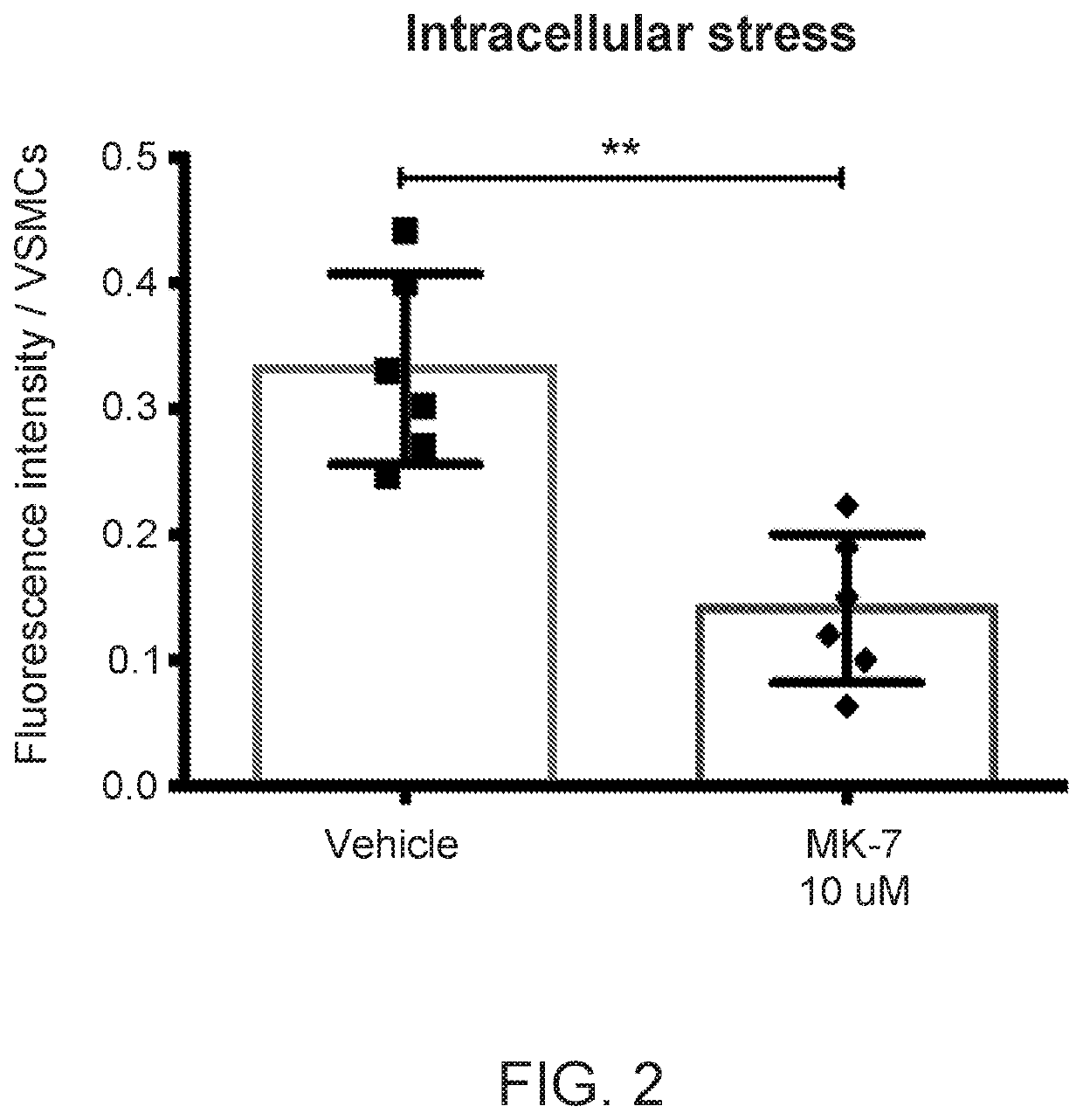Use of vitamin k in combination with anticoagulants
a technology of vitamin k and anticoagulants, applied in the direction of organic active ingredients, blood disorder, extracellular fluid disorder, etc., can solve the problems of blood delivery to the body, decline, muscle fatigue, and potential heart attack, and achieve low atp production, reduce blood flow, and reduce the effect of atp production
- Summary
- Abstract
- Description
- Claims
- Application Information
AI Technical Summary
Benefits of technology
Problems solved by technology
Method used
Image
Examples
examples
Example I (a)
Vitamin K Uptake in Vascular Smooth Muscle Cells (VSMCs)
[0070]Vascular smooth muscle cells (VSMCs) were grown until 80% confluence, and then the medium was changed to medium supplemented with 1 μM vitamin K2 (MK-7) or 1 μM vitamin K1. Cells were grown for 24 hours, and cells were harvested at time points 0, 1, 2, 4, 8, and 24 hours. Cells were lysed and vitamin K content was measured by HPLC. As shown in FIG. 1, the vitamin K uptake observed in VSMCs exposed to 1 μM vitamin K2 (MK-7) was superior to the vitamin K uptake observed in VSMCs exposed to 1 μM vitamin K1.
Example I (b)
Oxidative Stress in VSMCs
[0071]It is known that the level of reactive oxygen species in cells can be measured by measuring the conversion of 2′,7′—dichlorofluorescein diacetate (DCFDA) to the fluorescent dye 2′,7′-dichlorofluorescein (DCF). The fluorescence generated by cells subjected to DCFDA is directly proportional to the amount of oxidized DCFDA to DCF.
[0072]To perform the study, VSMCs (10,00...
example i (
f)
Conclusions
[0079]Based on the studies described in Examples 1(a)-1(e), it was concluded that VSMCs are able to take up vitamin K2 (MK-7) very efficiently and significantly better than vitamin K1. Interference with vitamin K metabolism (i.e., using warfarin to block the redox recycling of vitamin K) results in increased intracellular oxidative stress. The addition of vitamin K2 (MK-7) counteracts intracellular oxidative stress, both under normal conditions as well as under warfarin-induced oxidative stress conditions. Additionally, the HIF1a stabilizing cobalt chloride (inducing chronic hypoxia, as in during endurance sporting) induces increased oxidative stress, which might be detrimental for the muscle tissue. Also, under these circumstances, vitamin K2 (MK-7) seems to counteract hypoxia induced oxidative stress, indicative for improved mitochondrial activity. This effect was not found for UQ10, a known intermediate in the mitochondrial respiratory chain.
example ii
Vitamin K2 (MK-7) and ATP Pathway
[0080]This study was performed in order to determine the effect of vitamin K2 (MK-7) on warfarin-induced oxidative stress in muscles. To perform this study, human vascular smooth muscle cells (hVSMCs; 5,000 cells / well) were plated in 96-well dark plates and left to adhere overnight. Next, cells were incubated for 24 hours with either vehicle only (as blank control), warfarin (10 or 50 μM), vitamin K2 (MK-7) (10 μM), or a combination of warfarin (50 μM) and vitamin K2 (MK-7) (10 μM). Hoechst was added to correct for cell number (1 μg / mL). Next, ATP was measured using mammalian lysis buffer for 5 minutes after which 50 μL ATP substrate solution was added to the wells and incubated for 10 minutes in a dark environment. Finally, medium was transferred to a white plate to measure luminescence.
[0081]FIG. 6 shows the results of this study. Based on these results, it was determined that vitamin K2 (MK-7) counteracted the oxidative stress induced by warfarin ...
PUM
| Property | Measurement | Unit |
|---|---|---|
| temperature | aaaaa | aaaaa |
| flow rates | aaaaa | aaaaa |
| pressure | aaaaa | aaaaa |
Abstract
Description
Claims
Application Information
 Login to View More
Login to View More - R&D
- Intellectual Property
- Life Sciences
- Materials
- Tech Scout
- Unparalleled Data Quality
- Higher Quality Content
- 60% Fewer Hallucinations
Browse by: Latest US Patents, China's latest patents, Technical Efficacy Thesaurus, Application Domain, Technology Topic, Popular Technical Reports.
© 2025 PatSnap. All rights reserved.Legal|Privacy policy|Modern Slavery Act Transparency Statement|Sitemap|About US| Contact US: help@patsnap.com



